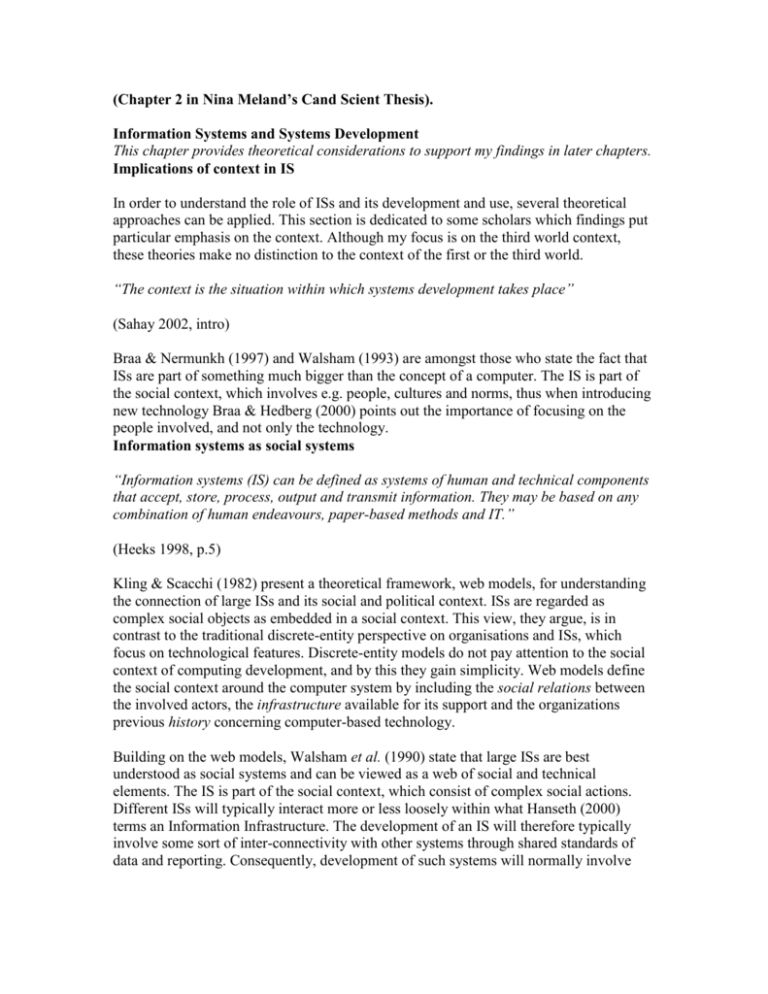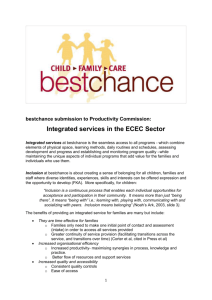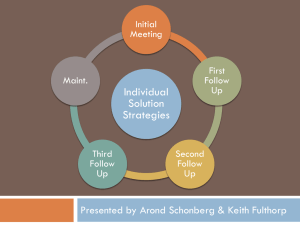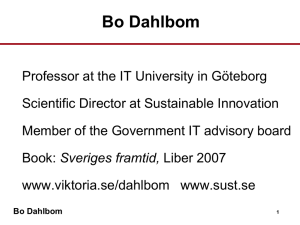(Chapter 2 in Nina Meland`s Cand Scient Thesis)
advertisement

(Chapter 2 in Nina Meland’s Cand Scient Thesis). Information Systems and Systems Development This chapter provides theoretical considerations to support my findings in later chapters. Implications of context in IS In order to understand the role of ISs and its development and use, several theoretical approaches can be applied. This section is dedicated to some scholars which findings put particular emphasis on the context. Although my focus is on the third world context, these theories make no distinction to the context of the first or the third world. “The context is the situation within which systems development takes place” (Sahay 2002, intro) Braa & Nermunkh (1997) and Walsham (1993) are amongst those who state the fact that ISs are part of something much bigger than the concept of a computer. The IS is part of the social context, which involves e.g. people, cultures and norms, thus when introducing new technology Braa & Hedberg (2000) points out the importance of focusing on the people involved, and not only the technology. Information systems as social systems “Information systems (IS) can be defined as systems of human and technical components that accept, store, process, output and transmit information. They may be based on any combination of human endeavours, paper-based methods and IT.” (Heeks 1998, p.5) Kling & Scacchi (1982) present a theoretical framework, web models, for understanding the connection of large ISs and its social and political context. ISs are regarded as complex social objects as embedded in a social context. This view, they argue, is in contrast to the traditional discrete-entity perspective on organisations and ISs, which focus on technological features. Discrete-entity models do not pay attention to the social context of computing development, and by this they gain simplicity. Web models define the social context around the computer system by including the social relations between the involved actors, the infrastructure available for its support and the organizations previous history concerning computer-based technology. Building on the web models, Walsham et al. (1990) state that large ISs are best understood as social systems and can be viewed as a web of social and technical elements. The IS is part of the social context, which consist of complex social actions. Different ISs will typically interact more or less loosely within what Hanseth (2000) terms an Information Infrastructure. The development of an IS will therefore typically involve some sort of inter-connectivity with other systems through shared standards of data and reporting. Consequently, development of such systems will normally involve “negotiation” with many other systems (Hanseth 2000), which again can be problematic due to e.g. different organisations, people, groups and standards. Braa & Sørensen (1998) look at systems as heterogeneous networks where people and technologies are connected and ‘everything is connected to everything’. An IS interlinks multiple elements, such as people, routines and forms. One of the first tasks to perform when developing an IS is to study the existing systems and the interconnections. Various authors, for example Hull (1994), Braa et al. (1995), Heeks et al. (1999), have pointed out the importance of systems development being culturally appropriate, and that solutions cannot be transplanted. A common problem is that expatriates do not understand the problem before they implement their solutions. It is although important that any changes do not interfere with something that is functioning well (Hull 1994). The more you change, the greater is the risk of failure (Heeks et al. 1999). Organisational change and systems development The design of the new system should not entail a radical change in the way people perform their jobs. Analysis has shown that the closer the design of the IS is to the current work practices, the higher the likelihood is that the users will accept the system (Silva 2001). Dahlbom & Mathiassen (1995) on the other hand, argue that: “The very idea of systems development is to change organizations.” (ibid., p.270) Introducing computers implies changes to the organization. The problems are rarely solved, but the situation is different. Changing a social organization is hard, especially to the better. Systems development is a creative process and it needs entrepreneurs that can cope with the changes involved and suggest novel solutions (Dahlbom & Mathiassen 1995). Dodd & Fortune (1995) also state that the greater change the health care IS represents, the larger is the risk of failure. On the other hand, if less change increases the possibility for system success, it might also reduce the organisational benefits of the system (Heeks et al. 1999). Pettigrew (1987) identifies vertical and horizontal levels and the interconnections between those levels through time in a contextualist analysis. Walsham (1993) uses this approach to understand organizational change, because of its focus on multi-level contexts, process and the link between process and context. Due to the politics inscribed in the existing health information in South Africa, “the process to change the system has been complicated and intimately linked to the wider political, social and health sector changes in South Africa.” (Braa & Hedberg 2000). Social systems are resistant to change, and to cope with understanding these kinds of ISs, “the larger social system needs to become part of the study” (Braa & Nermunkh 1997). Information infrastructure Hanseth (2000) defines information infrastructure as a complex web of ISs, including human, social and technical components, that grow over time and that are intertwined. Infrastructures have three types of aspects; they are enabling in the sense that they are supporting a wide range of activities, and it is shared by a larger community or group. Finally, infrastructures have openness; there are no limits to number of possible actors involved, being human or technical. Infrastructures are never developed from scratch; they are always based on a previous infrastructure, known as the installed base. Over time, as infrastructures have to adapt to new requirements, a new and larger installed base is slowly created and thus reinforcing itself. However, the infrastructure must be based on concepts of the “old” installed base, thus it is difficult to implement substantial changes, which implies that changes need to be incremental and piecemeal (Hanseth 2000). Braa & Nermunkh (1997) combine Walsham’s view of ISs being social systems (ref. section 0) while at the same time being information infrastructures, and state that the installed base is made up of a web of social systems. Structuration theory As a consequence of all the difficulties system development has encountered, the tendency now is that system development starts to draw upon other fields like anthropology, social theory, sociology of knowledge and philosophy (Sahay 2002). One sociologist whose theory has become one of the main strands of “qualitative”, interpretivist mode of research in the IS community, is Anthony Gidden’s structuration theory (Livari 1998). The structuration theory is not a methodology for systems development, but the theory can provide a fundamental understanding of organizational context, which might be useful in order to perform successful systems development. One of the means of the theory was to resolve a debate between two social theories, one focusing on human agents and human actions, and the other focusing on the structure of social systems. These two directions can be thought of as context and process, respectively. Giddens' way to resolve this debate is to look at agents and structures represented as a duality, which is something that influence and draw upon each other (Walsham 1993). As Giddens puts it: ‘By the duality of structure I mean that social structures are both constituted by human agency, and yet at the same time are the very medium of this constitution’ (Giddens 1976, p.121) Structure is shaped by human interactions. Hence, social structures are produced and reproduced (Walsham 1993). ‘A structure can be described ‘out of time’, but its ‘functioning’ cannot.’ (Giddens 1976, p.119) INTERACTION Communication (MODALITY)Interpretative scheme STRUCTURE Signification Power Facility Morality Norm Domination Legitimation Figure 1: Duality of structure in social interaction (Giddens 1976, p.122) The theory is illustrated in Figure 1. Social structures and human interaction are divided into three dimensions and interlinked by three modalities, which refer to the mediation of interaction and structure in processes of social reproduction. The three dimensions are very closely interlinked and exist as a whole, but are divided in the diagram for analytical reasons to show how one interpret the connections between human interaction and structures. While the first line holds issues related to interaction, the third line is indications of structures (Giddens 1976). These schemes can be described as stocks of knowledge that actors draw upon to understand their own and others’ actions. With this they produce structures of signification, which mean they produce and reproduce structures of meaning. Communication involves the use of interpretative schemes. Power is utilized in interaction when actors are drawing upon facilities and resources. This creates, reinforces and changes structures of domination. Human actors sanction their actions, which mean that they draw on norms or standards of morality. In that way structures of legitimation are maintained or modified (Walsham 1993). As we see in Figure 1, social action can reproduce existing social structures and at the same time also produce new structures. Structuration theory and information systems Walsham (1993) and Orlikowski (1992) draw upon structuration theory to understand the role of technology in organizations. Walsham presents a practical framework for analysis in “Organizational change: Context and process” (Walsham 1993). The framework is concerned with the process of change and its links with intraorganizational and broader context. He claims that ISs are deeply involved in the modalities that link social process and social context together. Walsham (1993) has developed a framework for understanding organisational change, including four main components: The content can involve changes to products, processes and systems, such as technology. Web models are used to identify the social context (section 0). A cultural and political view on the organizational change is considered to help understand the social process. The structuration theory applied as a linkage between social context and social process. Social context and social process are linked by modalities in which the ISs are involved: “Computer-based IS embody interpretative schemes, provide co-ordination and control facilities, and encapsulate norms. They are drawn on in the social processes which take place in organizations, and in doing social structures are reinforced or changed.” Walsham (1993, p. 162) Orlikowski (1992) builds on Giddens’ structuration theory to examine the effect of information technology in organizations. She presents a model including human agents, technology and institutional properties, where structuration is understood as a dynamic process that is embedded historically and contextually in the organisation. The relationships in the model are considered stable, but their range, content and relative power will vary and change over time. Systems development and strategy There are several different strategies and developing models to choose from on how to go about to develop and implement a new IS. This section starts with presenting some strategies for use, before a number of frameworks are outlined. Strategies for development Cultivation, participatory design and prototyping are all commonly used strategies when performing systems development in context sensitive fields. The Scandinavian approach is known for involving the users in the development process, where participatory design and prototyping are the main ingredients. Cultivation Braa (1997) uses the notion cultivation as an important framework when performing systems development in a multileveled and sensitive context. Cultivation aims at taking the local resources into use, and the IS is viewed as a social system (ref. section 0). Commitment and ownership at local level is vital in order to make a sustainable IS. One strategy for creating such an ownership is to use a participatory process, based on a slow bottom-up approach. Dahlbom & Janlert (1996) refer to cultivation as an approach of building on what already exist in the process of change. Instead of designing a product, you are cultivating a process (Dahlbom & Mathiassen 1995). Participatory design “In terms of the actual work the system is intended to support, the users are the experts”. (Braa, K. 1995) Participatory design underlines the importance of the user and the improvement in their work lives. The users, or user groups, are given equal opportunity to determine system requirements and in approving system design. It is quite common that the system developers work as advisers for the users (Hoffer et al. 1999). There are usually given three motives for user participation (e.g. Bjørn-Andersen & Hedberg 1977): To improve the knowledge upon which systems are built. To enable people to develop realistic expectations, and reduce resistance to change. To increase workplace democracy by giving the members of an organization the right to participate in decisions that is likely to affect their work. The idea of the first two motives is that the system will fit the work with help of users’ knowledge. The third motive is concerned with cultural and political issues. Bjerknes & Bratteteig (1995) emphasize the importance of taking other strategies that aim at relevant areas of influence into account when using user participation techniques. As an example, global strategies should provide a framework for local action, and local strategies should include several interest groups, not only one (ibid.). Heeks et al. (1999) argue that participative approaches in developing health care ISs, is a fundamental reason for reducing reality gaps, i.e. the gap between the system designed and the reality. The idea of having several people or groups working together based on an equivalent collaboration, may be difficult in some contexts. Prototyping Prototyping is an activity and a method within evolutionary system development, which is utilized when there is uncertainty concerning what technology to use and what the customer's requirements are (Mathiassen et al. 2000). Sommerville (2000) describes a prototype as an initial version of a software system that is used to demonstrate concepts and try out design options. Prototyping implies producing early versions of future applications, services and solutions, and in that way create a basis for discussions among groups involved in the development process. The prototype thus gives the users an early feeling about the future system, and misunderstandings can be solved at an early point in the process (Buddhe 1992). Formal and well-established user groups turned out to be a problem when developing a HIS in South Africa. Because of the political and administrative structure, the methodology was based on improvisation; a more informal approach was adopted, where the users had full access to the development team (Braa & Hedberg 2000). The Scandinavian approach The Scandinavian approach builds on a democratic work life, and is known for its strong focus on participatory design, e.g. to create local ownership. Because of its politically significant, interdisciplinary, and action-oriented research on resources and control in the processes of use and design, it often labelled as the Scandinavian approach. Ehn (1993) calls this approach a work-oriented approach, and uses the UTOPIA project as an example. The UTOPIA project emphasized mutual learning, understanding and communication during the design process, observations and other prototyping design artefacts (ibid.). Lyytinen et al. (1998) characterise the Scandinavian approach as a “grass root” approach because it tend to focus on small scale development of individual application systems, instead of the total IS. Although the Scandinavian context is quite different from the ones presented in the third world, it can provide useful means to the development process. Development models There are different models to software development, and this section outlines some of them. These are quite different frameworks, and usually more than one approach is used in systems development projects. The waterfall model The waterfall model describes a development method that is linear and sequential. It is a stepwise process, and once a phase of development is completed, the development proceeds to the next phase. The requirements are detailed and complete, and every phase results in a document. The process is divided into separate phases, which begins with a definition of the requirements and ends in operation and maintenance. Possible risks are pushed forward in the phase. The waterfall model is suitable when the requirements are clear and user participation is minimal (Sommerville 2000). Evolutionary model As a reaction to the problems associated with the waterfall model, the evolutionary model was developed. The basic idea of evolutionary development is to develop an initial implementation, and based on feedback from the users, the system is improved until a satisfactory version is in place. The specification and development process consists of cyclical stages in order to understand the requirements. The evolutionary model is suitable for the development of small systems where the complexity is low and the uncertainty is high (Sommerville 2000). Spiral model Few projects make use of only one development model. Several models are often used in one project, something Sommerville (2000) refers to as hybrid development. One of the hybrid models is the spiral model. The process is represented as a spiral, where each cycle symbolizes a phase of the software process: 1. Objective setting: Specific goal for this phase is defined. 2. Risk assessment and reduction: The key risk is identified and analyzed. 3. Development and validation: A suitable model is chosen based on the risk evaluation. 4. Planning: The project is evaluated and plans are made if it is necessary to continue the process. The spiral model is iterative the four phases are repeated until the user are satisfied with the system. The major focus on risk handling is an important difference between the spiral model and other software process models (Sommerville 2000). Incremental development Incremental development combines the advantages of the waterfall model and the evolutionary model. Mills et al. (1980) proposed the incremental approach with the aim of reducing rework in the development process, while being able to delay requirements until customers had some experience with the system. Different processes can be applied in each increment, and the most important services are completed first and put into use. Incremental development has several advantages: Users gain value from the first increment. The first increment results in a prototype, which makes it easier to define further requirements. The risk of overall project failure is reduced. Since there are several increments, problems are solved as they are discovered. As the most important requirements are delivered in the first increments and later increments are integrated with them, the most important system services receive the most testing. The limitations of incremental development are that increments should be rather small and each increment needs to deliver some system functionality (Sommerville 2000). Summary I have in this chapter described several theoretical considerations relevant for my research. These represent quite different approaches, and although one cannot relate to the entire view, parts of them can be useful in most areas. In order to understand large ISs, several scholars have developed frameworks that take the larger context into account. Walsham et al. (1990) build on Kling & Scacchis (1982) web models, and argue that large IS are best understood as social systems. Social systems are resistant to change, and to understand how the process of change is linked with the broader context, Walsham (1993) draws upon Giddens’ structuration theory. Giddens’ theory has been used by several IS scholars and is concerned with how human actions are produced and reproduced through social structures. When developing systems in a context sensitive field, the content of the context must be taken into account, which includes the existing web of ISs, and the installed base (Hanseth 2000). Taking the overall complexity into account, we see that changes must be incremental and piecemeal. During the design process, several approaches stress the need for user participation, as the users are the experts.










